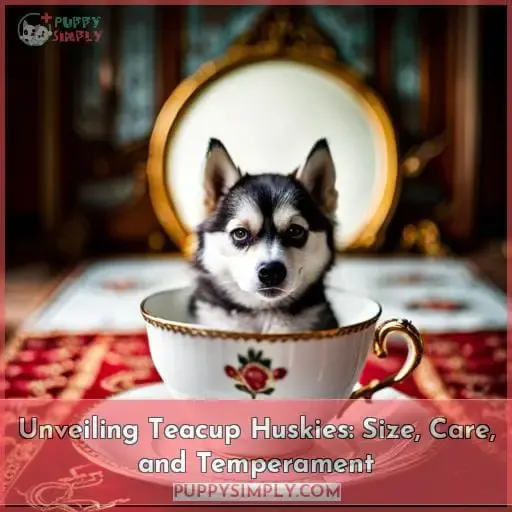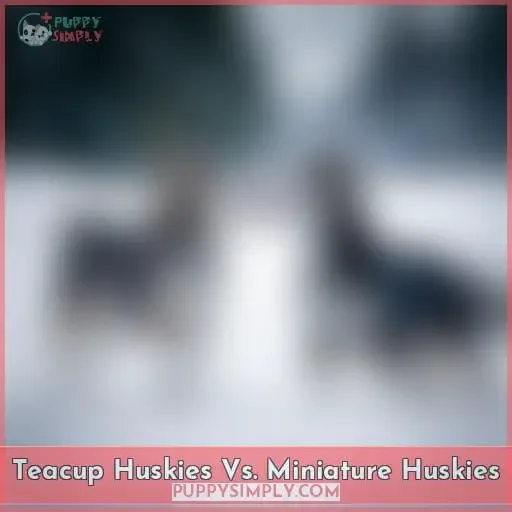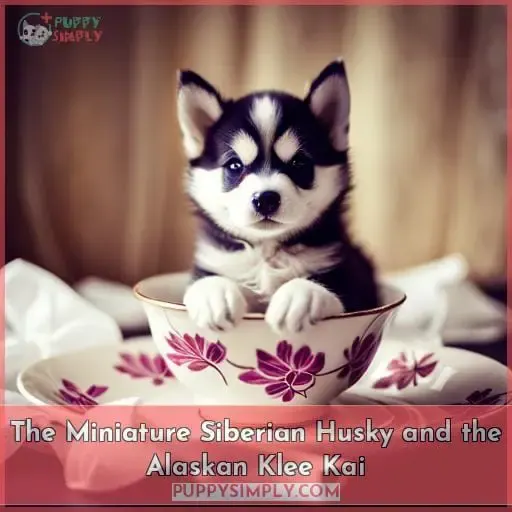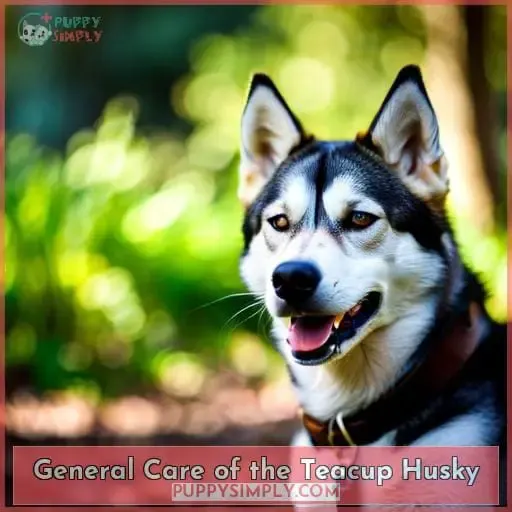This site is supported by our readers. We may earn a commission, at no cost to you, if you purchase through links.
 Ready to meet the pint-sized version of your favorite sled dog? If you’re a fan of Siberian Huskies, then it’s time for you to get up close and personal with Teacup Huskies. These tiny pooches are becoming increasingly popular among pet owners who love their wolf-like appearance but don’t have enough space or energy levels for full-size huskies.
Ready to meet the pint-sized version of your favorite sled dog? If you’re a fan of Siberian Huskies, then it’s time for you to get up close and personal with Teacup Huskies. These tiny pooches are becoming increasingly popular among pet owners who love their wolf-like appearance but don’t have enough space or energy levels for full-size huskies.
Their small size can make them look even cuter than regular-sized Husky dogs! But before taking one home, it is important to know all about this breed: from its history and physical traits, health concerns, and general care requirements – right down to its temperament and trainability.
In this article, we will cover everything there is to know about the beloved teacup husky so that potential owners can make an informed decision on whether these miniature pooches are best suited for their lifestyle or not.
Table Of Contents
- Key Takeaways
- History of Teacup Breeds
- Teacup Huskies Vs. Miniature Huskies
- The Miniature Siberian Husky and the Alaskan Klee Kai
- How Big Will a Teacup Husky Get?
- Health Concerns of Teacup Husky-Type Dogs
- General Care of the Teacup Husky
- Temperament and Trainability of the Teacup Husky
- A Suitable Home for a Teacup Husky
- Does This Dog Breed Have a Good Temperament?
- Do They Have a Strong Prey Drive?
- Conclusion
Key Takeaways
- Teacup Huskies originated on the Chukchi Peninsula for sledding and were later transformed into smaller versions due to size misconceptions.
- Teacup Huskies are not an officially recognized breed and can vary in size based on breed mix.
- Teacup Huskies are prone to health issues such as collapsing tracheas, hypoglycemia, and hydrocephalus.
- Teacup Huskies require proper exercise, a suitable diet, grooming, and training to thrive in an ideal home environment.
History of Teacup Breeds
You may have heard of the term ‘teacup’ being used to describe certain breeds, but its origin and history are complex and often misconstrued.
Teacup Breeds originated on the Chukchi Peninsula around 4,000 years ago when they were developed by the Chukchi people for sledding. These small dogs were then transported to Nome, Alaska during the 1908 Gold Rush, where their popularity bloomed as racing dogs.
Over time, Siberian Huskies transformed into smaller versions with size misconceptions leading to a market of novelty designer breeds labeled teacups—which in reality do not exist! Alternatives include Miniature Siberian Huskies or Alaskan Klee Kais, which both share similar traits yet require specific size standards for health reasons such as hypoglycemia or hydrocephalus from selective breeding techniques that produce small huskies.
The cultural influence behind these tiny pooches has created an increasing demand for playful companions who are loyal with high energy levels.
Teacup Huskies Vs. Miniature Huskies
Are you considering a Teacup Husky? Although most people are familiar with toy and miniature breeds, there is also the teacup option. Teacups are different from other small-sized dogs as they can be created through selective breeding or crossbreeding with toy breeds, making them an attractive choice for those looking for something unique.
It’s important to note that although these dogs can look quite charming, they require careful breeding and may have more health concerns than standard-sized ones.
Teacup or Micro-sized Dogs
Looking for a pint-sized pooch to keep you company? Micro-sized dogs might be the perfect fit! Teacup Husky Misconceptions abound, such as their size and breed specifications. But what are some of the health risks associated with these tiny breeds? Training challenges may arise due to size limitations, while breeding controversy can occur if not performed ethically.
Toy Breeds
Compare Miniature Huskies to Toy Breeds. The latter often weigh between 4 and 7 pounds and are bred exclusively for companionship. Toy breeds can have a variety of characteristics depending on their breed lineage, but generally require less exercise than larger dogs.
They are also known for having higher energy levels and intelligence, which can present training challenges.
Size considerations should be taken into account when considering toy breeds, as they may not fit in all living spaces or lifestyles due to grooming needs or health issues such as tracheal collapse, hypoglycemia, or hydrocephalus.
Breeding controversies exist around the result of breeding teacup-sized dogs. However, miniature Siberian Huskies offer an alternative option that offers many of the same traits without the health risks associated with designer dog breeding.
Miniature Dogs
Miniature dogs are smaller versions of standard breeds while still maintaining their original characteristics. When considering a miniature dog, it is important to consider the importance of training techniques, socialization, and exercise methods for successful bonding activities.
Size considerations should be taken into account as well when making decisions about teacup husky or mini husky breeds – they may have different physical appearances but also require regular grooming and can face health issues due to their size.
The Miniature Siberian Husky and the Alaskan Klee Kai
The Miniature Siberian Husky and the Alaskan Klee Kai are two breeds that offer alternatives to the elusive teacup husky. Although not officially recognized by any kennel clubs, both of these miniature sizes have gained a great deal of popularity.
The Miniature Siberian Husky is slightly larger than its teacup counterpart, standing between 13-17 inches tall and weighing 20-35 lbs when fully grown. This small breed has high energy levels, requiring frequent exercise, proper socialization training techniques, as well as coat maintenance in order to keep them looking their best.
On the other hand, Alaskan Klee Kais are smaller still with specific size specifications, but they also share some similar traits with regular-sized Siberian Huskies, such as loyalty and intelligence. This makes them an ideal companion for active owners who don’t mind exercising multiple times daily or providing ample mental stimulation through playtime activities or obedience classes.
While there is evidence suggesting both can excel at agility contests like full-sized huskies, it’s important for potential owners to research thoroughly before taking on one of these miniaturized versions.
This is due to increased chances they may be prone to health issues, including hypoglycemia, hydrocephalus, and collapsing tracheas.
How Big Will a Teacup Husky Get?
Unfortunately, there’s no such thing as a true teacup Husky—despite what some may tell you. The size of a Teacup Husky varies greatly and depends largely on the breed mix used in its creation. A Teacup could be anywhere from 4 pounds to 20 pounds when fully grown, making it difficult to predict their eventual size until they have reached maturity.
This unpredictability can cause challenges for owners who are looking for an appropriately sized companion dog that will fit into their lifestyle and living space needs.
Size Realities & Growth Challenges:
- Breeding dogs with smaller sizes is not without risks or potential health issues due to the evolutionary process involved in achieving this goal.
Evolutionary Traits:
- Relying solely on evolution over time has also resulted in mixed results between breeds.
Misconceptions about Size:
- Many people have misconceptions regarding ‘Teacup’ sizes because they often do not understand how certain traits were passed down through generations of breeding.
Miniature Health Concerns:
- Additionally, small-sized dogs tend to suffer more from various health concerns due to their miniaturized bodies having trouble regulating temperature or fighting off infections effectively.
Careful Considerations Necessary:
- To ensure your pet’s long-term wellbeing, careful consideration must be taken before choosing any puppy regardless of its breed mix or ‘teacup’ label designation.
Health Concerns of Teacup Husky-Type Dogs
Are you considering a teacup husky-type dog? There are many potential health issues that need to be taken into account, including musculoskeletal problems, organ diseases, type 1 zinc deficiencies, and eye problems.
It’s important to do your research before making any decisions so as not to put your pup at risk of developing any serious medical conditions in the future.
Health Issues in Teacup Breeds
Sadly, teacup breeds are more likely to suffer from health issues than their larger counterparts. They can have up to a three times higher risk of collapsing trachea. Common issues such as hypoglycemia and hydrocephalus should be taken into consideration when thinking about getting a Teacup Husky.
Size considerations are also important for these miniature dogs. Smaller dogs need extra care in order to stay healthy. Longevity factors like diet and exercise must also be taken into account. Proper health precautions should be observed by owners at all times due to the vulnerable nature of these tiny pups.
Breeding risks should always be carefully evaluated before bringing home any type of teacup husky-type dog, including Miniature Huskies or Alaskan Klee Kai. These dogs may not come with all the same risks associated with full-size Siberian Huskies, but they still require special attention in terms of preventing potential medical problems down the road.
Musculoskeletal Problems
You’re drawn to their tiny size, but musculoskeletal problems can make teacup-type dogs suffer needlessly. Poor joint health and bone development are common in undersized breeds due to their small stature and rapid growth rate.
Mobility issues may lead to posture challenges or skeletal conditions such as luxating patellas or hip dysplasia.
A balanced mini husky diet, along with regular exercise, is key for optimal growth and healthy joints throughout life.
Keep a close eye on your teacup husky’s nutrition, activity level, and weight gain/loss.
Organ Diseases
Organ diseases are a common concern among teacup-sized dog breeds. Common conditions include heart and lung disease, kidney problems, eye disorders, liver issues, and diabetes. Diagnostic approaches range from blood tests to X-rays or ultrasounds in order to identify any abnormalities present.
Treatment options may involve medications such as antibiotics for infections or insulin for diabetes management. Diet changes can also be necessary depending on the condition diagnosed. Preventive measures should be taken, such as regular vet checkups and vaccinations.
The impact on lifespan depends largely on how well these preventive steps are taken throughout life. Early diagnosis is key in providing long-term care for miniature huskies with organ diseases.
Type 1 Zinc Deficiencies
You may find your Type 1 Zinc Deficient teacup husky-type dog is prone to certain organ diseases. Nutritional considerations are vital for the breed’s health, as zinc deficiencies can have a major impact on their skin and other organs.
Symptoms include hair loss, thinning of coat colors, and dry, flaky skin. Treatment involves providing nutritional supplements containing zinc or switching to a food with higher amounts of it. Preventing these issues starts by ensuring the diet meets all nutritional requirements specific to this energetic dog breed, such as Siberian Huskies or toy breeds, in terms of temperament and coat colors.
Eye Problems
Be aware that these types of dogs can be prone to eye problems, including glaucoma and cataracts. Common eye issues for teacup husky-type dogs include retinal diseases, corneal ulcers, dry eyes, and progressive retinal atrophy (PRA).
Regular vision care is important in order to prevent blindness or other serious conditions from developing. It’s also essential that you are aware of any genetic traits that could increase the likelihood of your dog developing an ocular health issue before bringing them home.
Preventing blindness requires providing proper nutrition as well as regular exercise with plenty of mental stimulation.
Intelligence combined with trainability makes teacup huskies easy to handle due to their obedient nature and low prey drive, making training techniques easier than ever!
General Care of the Teacup Husky
If you’re considering a teacup husky, it’s important to be aware of their energy levels and exercise needs. These little dogs need plenty of physical activity — at least an hour per day — and mental stimulation in order to stay healthy.
Additionally, they will also require ample space for running around since they can’t usually fit into standard-sized housing units.
When it comes to food, these pups should have a balanced diet with high protein content, low fat amounts, and low carbohydrates as well.
Grooming is another essential factor here as regular brushing is necessary in order to keep them looking good all the time!
Energy Levels
Miniature Huskies, with their high energy levels and loyal personalities, are like a bundle of joy running around your house. For owners who want to keep them as healthy and happy as possible, it’s important to understand how best to manage their energy.
Exercise routines, playtime activities, and managing hyperactivity all provide great outlets for these energetic little dogs. When providing exercise for your Mini Husky, make sure the activity is appropriate.
Additionally, playtime activities such as fetch can help tire out an overly-active pup while also helping bond between you two! Managing hyperactivity can be done through calming techniques like teaching impulse control commands (e.
g., sit) that will occupy his mind when he’s feeling too rambunctious in order to prevent any unwanted behaviors from developing.
Allowing him time outside on-leash each day with plenty of interactive toys helps ensure proper physical stimulation during those moments when they become bored indoors so they don’t take matters into their own hands – quite literally!
Exercise Needs
Exercise is essential for keeping your pup active and healthy, so plan on at least an hour a day. Depending on the space you have available in your home, indoor alternatives like agility courses and interactive toys can help with his exercise needs.
Playtime routines should also be implemented to engage him mentally as well as provide physical activity variations such as running or fetching games outdoors.
Dietary requirements must be met while providing adequate amounts of daily exercise for these high-energy dogs. This means if you don’t live an active lifestyle already, it’s best not to take one into your family due to its specific needs.
Housing Needs
When considering a Mini Husky for your home, make sure you have enough room to accommodate their active lifestyle. They can adapt well to compact living if given sufficient indoor exercise options and creative outlets such as playtime with family members.
Additionally, it is important that they are in an environment suited for them; for example, a cozy apartment or house where they can be the center of attention without being cramped and uncomfortable.
A suitable home must provide plenty of space for regular walks outside.
Apartment compatibility hinges on how much time owners spend playing indoors with their pup.
Regular brushing is necessary due to these dogs’ thick double coats, but should not require too much additional space.
Miniature Huskies are loyal family pets that come from a rich Alaskan history – providing the right housing needs will ensure many years of joy!
Food and Dietary Requirements
Feeding your pet the right food is essential for its health and wellbeing, like a puzzle you need to get all of the pieces in their correct place. Meal planning for teacup huskies should follow nutritional guidelines that provide enough protein, fats, carbohydrates, vitamins, and minerals while avoiding dietary restrictions.
A consistent feeding schedule helps regulate metabolism patterns similar to those developed by the Chukchi tribe breeders who first domesticated them thousands of years ago. Healthy treats are also important as part of an overall diet plan curated with help from Bree Normandin or other canine nutritionist experts if needed.
Providing nutrient-rich meals without overfeeding will ensure your teacup husky can live a long healthy life full of energy and joy– everything it needs to thrive!
Grooming Needs
Regular grooming is essential for keeping a teacup husky looking and feeling its best. A brushing routine should be done twice weekly with a slicker brush to remove dirt, debris, and mats from the coat while promoting natural oils throughout the fur.
Bathing tips include using lukewarm water and mild shampoo only when necessary. Too much bathing can strip the fur of essential oils.
Grooming tools such as combs or rubber curry brushes help detangle hair that’s prone to knots easily due to their double-coat feature. Shedding control requires regular brushing plus special shampoos/conditioners designed specifically for Huskies’ thick coats.
With timely care, your teacup husky will look fabulous!
Temperament and Trainability of the Teacup Husky
Although tiny, Teacup Huskies have a big personality. Bred from the Siberian Husky and bred to be small, they are intelligent and highly trainable dogs that make great companions for those who can provide them with enough exercise.
Temperament
Although they may be small, these dogs have big personalities and need an owner who can provide regular attention and training to keep them well-behaved.
To ensure a Teacup Husky is compatible with their family, proper socialization is essential.
Training tips should involve positive reinforcement methods.
Potential behavior challenges should be addressed early on in life for best results.
Exercise needs must also be met to prevent boredom-related issues from arising due to a lack of stimulation or mental engagement activities like hide & seek playtime with owners!
Finally, proper dieting plans are necessary as this breed has a higher metabolism than larger breeds, which could lead to health concerns if not monitored regularly by the family vet doctor or professional food specialist nutritionist for pets!
Intelligence
You’ll need to stay dedicated to training your teacup husky, as their intelligence and eagerness for learning can make them a challenge. They have the cognitive abilities to absorb new information quickly and possess an impressive capacity for problem-solving.
With consistent practice, they are able to retain knowledge well over time due to their adaptability, making it easier when introducing new commands or teaching tricks. Teacup Huskies also demonstrate good decision-making skills during times of stress or uncertainty, allowing owners who understand these traits more control in uncertain situations with positive reinforcement.
Trainability
No matter how cute they look, these tiny little furballs can be a handful to train. Teacup Huskies possess the same intelligence and cognitive abilities as regular Siberian huskies but require higher amounts of patience during training sessions due to their challenging nature.
Obedience skills must be taught early on, and consistent reinforcement methods are necessary for them to understand commands properly.
Socialization is also important in order for teacup Huskies not to become too stubborn or independent when it comes time for behavioral patterns such as walking on a leash or interacting with other animals.
A Suitable Home for a Teacup Husky
When considering a suitable home for a teacup husky, there are several important factors to consider. First, it’s essential to recognize that these dogs require an ideal environment with plenty of space and social interaction.
Additionally, potential owners must be aware of allergy considerations as the breed does have fur, which may trigger allergies in some people.
Finally, prospective owners should understand the need for regular exercise routines and grooming demands associated with this small but high-energy breed.
Teacup Huskies can indeed make great family pets if they are given all they need in terms of attention from their owner(s).
Those interested would do well researching further into what owning a teacup husky entails so they can give them everything necessary for optimal health throughout its life cycle!
Does This Dog Breed Have a Good Temperament?
It’s important to understand the temperament of this breed before bringing one home. Teacup Huskies are active, social dogs that can be good with children and other animals when properly trained.
They may bark at strangers or become aggressive if not handled correctly, so early training is essential for successful interactions with others outside their family circle. Teaching them basic obedience commands helps in developing a responsive relationship between owner and pet based on trust and understanding.
The playfulness of these pups makes them great companions for an active lifestyle; however, it also requires consistent attention from its owners as part of its mental stimulation needs to prevent behavioral issues such as hyperactivity or aggression later on in life due to boredom or stress-related situations arising from a lack of engagement activities provided by his human carer/s.
Though the small size might imply fragility, it could make some believe Teacup Huskies don’t belong within households that have young kids around.
Do They Have a Strong Prey Drive?
You may have heard that Mini Huskies have a strong prey drive. This trait is similar to their larger Siberian Husky ancestors, making them more prone to chasing small animals. Fortunately, with proper behavioral training and socialization techniques, this can be managed in the home environment.
Here are 4 steps for managing a mini husky’s prey drive tendencies:
- Provide plenty of play and exercise opportunities.
- Introduce new toys or activities that will distract from potential targets.
- Socialize your pup as early as possible with other dogs and people.
- Be consistent when teaching commands like ‘leave it’ or ‘drop’.
With these tips in mind, you can help your miniature husky become an obedient companion while still enjoying its natural prey-driven activities!
Conclusion
It’s no secret that ‘teacup’ huskies are a much sought-after pup, but the reality is, they’re actually a misnomer. The truth is, a teacup husky is not a breed; it’s a marketing term for a crossbreed of a toy breed and a miniature husky.
While these dogs may be small, they come with all of the same energy, loyalty, and intelligence of regular-sized huskies. This means that they require regular exercise, proper training, and lots of attention.
Owners of these little pups must also be aware of the potential health issues associated with them, such as musculoskeletal problems, organ diseases, and zinc deficiencies. A suitable home for a teacup husky is one that is prepared for the pup’s grooming needs and understands the pup’s energy needs.
Overall, a teacup husky is an adorable, high-energy pup that needs owners who are prepared to give them plenty of exercise, training, and attention. With the right home and care, these pups can live active and healthy lives for up to 12-15 years.
















